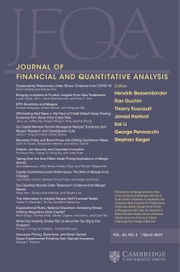No CrossRef data available.
Article contents
Regional Clusters and Product Market Outcomes During Turbulent Times
Published online by Cambridge University Press: 24 January 2025
Abstract
We examine whether location within a dense regional cluster of interconnected businesses affected firm performance during the Great Recession and the subsequent recovery. Firms in denser regional clusters experienced faster sales growth than their rivals in less dense clusters, especially firms operating in more competitive industries and those more able to reap agglomeration benefits. They also faced lower uncertainty, invested more in both physical capital and intangible capital, and maintained higher employment growth. Their greater resiliency and agility led to significant increases in their valuations. These results suggest that regional clusters provide competitive advantages during turbulent times.
Information
- Type
- Research Article
- Information
- Journal of Financial and Quantitative Analysis , Volume 60 , Issue 7 , November 2025 , pp. 3475 - 3513
- Creative Commons
- This is an Open Access article, distributed under the terms of the Creative Commons Attribution licence (http://creativecommons.org/licenses/by/4.0), which permits unrestricted re-use, distribution and reproduction, provided the original article is properly cited.
- Copyright
- © The Author(s), 2025. Published by Cambridge University Press on behalf of the Michael G. Foster School of Business, University of Washington
Footnotes
We thank an anonymous referee, Ran Duchin (the editor), and seminar participants at Queen’s University – Belfast, the University of Arizona, the University of Oklahoma, and the University of Tennessee.

